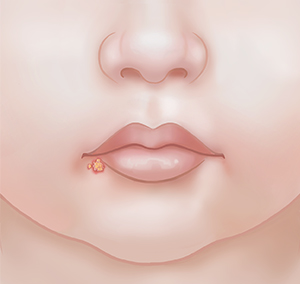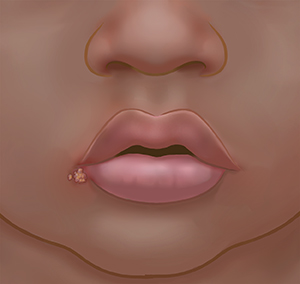When Your Child Has Cold Sores
Cold sores are also called fever blisters. They are a common problem in children. They usually appear outside the mouth. Cold sores often start as 1 or a cluster of blisters, which then crust or scab over.
They can spread through direct contact. If your child has cold sores, it’s important to teach them how to keep from spreading them to others.
 |
| Cold sore on light skin. |
 |
| Cold sore on dark skin. |
What causes cold sores?
-
Cold sores are caused by the herpes simplex virus (HSV). There are two types of this virus. The type that usually affects the mouth is called HSV1. It’s very common in children.
-
HSV stays in the body once your child has it. Cold sores can appear randomly or when something triggers them. Triggers can include:
-
An injury to the mouth
-
Fever or illness
-
Stress
-
Sun exposure
-
Very hot or cold temperatures
-
Lack of sleep
-
Friction or rubbing mouth
-
Dehydration and poor diet
-
Changing hormones, usually during puberty
What are the symptoms of cold sores?
Symptoms can include tingling, burning, or itching felt in the affected area a few days before the appearance of sores. The sores themselves can cause burning, stinging, or itching. The sores are often blister-like and red at first. They then dry out and scab over. Cold sores may last 10 to 14 days.
How are cold sores spread?
Cold sores can be spread in the following ways:
-
Direct contact with the sores, such as through touching or kissing
-
Contact with items, such as cups, toothbrushes, or towels that have been contaminated by an infected person
How are cold sores diagnosed?
Cold sores are diagnosed by how they look. To get more information, the healthcare provider will ask about your child’s symptoms and health history. The healthcare provider will also examine your child. You will be told if any tests are needed. A skin biopsy or viral culture can also be done. This is rarely needed.
How are cold sores treated?
-
Cold sores generally go away within 10 to 14 days with no treatment.
-
Ask the healthcare provider if there are any prescriptions or over-the-counter (OTC) medicines that will help your child feel better, faster. Topical or oral antiviral medicine can be prescribed if your child has recurrent cold sores. To work best, the medicine needs to be taken as soon as symptoms appear.
-
You can do the following at home to ease cold sore symptoms:
-
Make sure your child gets plenty of rest.
-
Give your child OTC medicines, such as ibuprofen or acetaminophen, to treat pain and fever. Don't give ibuprofen to an infant less than 6 months of age, or to a child who is dehydrated or constantly vomiting. Don't give aspirin to a child 18 years of age or younger with a fever. This can put your child at risk of a serious illness called Reye syndrome.
-
Cold liquids, ice, or frozen juice bars may help soothe mouth pain. Don't give your child spicy or acidic foods.
-
Use these treatments only if your child is over the age of 4:
-
Apply an OTC numbing gel to mouth sores to relieve pain. The gel can cause a brief sting when applied.
-
Have your child rinse their mouth with saltwater or with baking soda and warm water, then spit. The mouth rinse should not be swallowed.
When to call the healthcare provider
Contact the healthcare provider if your child has any of the following:
-
A cold sore that doesn’t go away within 14 days
-
Cold sores that come back often
-
A cold sore that grows larger or appears near the eyes
-
Increased mouth pain
-
Trouble swallowing
-
Signs of infection around a cold sore, such as pus, drainage, or swelling
-
Signs of dehydration, such as very dark or little urine, excessive thirst, dry mouth, or dizziness
-
Your child has a fever (see Fever and children, below)
-
Your baby is fussy or cries and can't be soothed.
-
Your newborn develops a blister-like rash or fever
-
Your child has a headache, combined with confusion, seizure, or fever during a cold sore outbreak
Fever and children
Use a digital thermometer to check your child’s temperature. Don’t use a mercury thermometer. There are different kinds of digital thermometers. They include ones for the mouth, ear, forehead (temporal), rectum, or armpit. Ear temperatures aren’t accurate before 6 months of age. Don’t take an oral temperature until your child is at least 4 years old.
Use a rectal thermometer with care. It may accidentally poke a hole in the rectum. It may pass on germs from the stool. Follow the product maker’s directions for correct use. If you don’t feel OK using a rectal thermometer, use another type. When you talk to your child’s healthcare provider, tell them which type you used.
Below are guidelines to know if your child has a fever. Your child’s healthcare provider may give you different numbers for your child.
A baby under 3 months old:
-
First, ask your child’s healthcare provider how you should take the temperature.
-
Rectal or forehead: 100.4°F (38°C) or higher
-
Armpit: 99°F (37.2°C) or higher
A child age 3 months to 36 months (3 years):
-
Rectal, forehead, or ear: 102°F (38.9°C) or higher
-
Armpit: 101°F (38.3°C) or higher
Call the healthcare provider in these cases:
-
Repeated temperature of 104°F (40°C) or higher
-
Fever that lasts more than 24 hours in a child under age 2
-
Fever that lasts for 3 days in a child age 2 or older
How is the spread of cold sores prevented?
Follow these steps to keep your child from passing cold sores on to others:
-
Teach your child to wash their hands with soap and clean running water often. Handwashing is especially important before eating or handling food, after using the bathroom, and after touching the sores.
-
Teach your child not to scratch or pick at cold sores. This can spread the virus to other parts of the body, such as fingers and eyes.
-
Don't allow your child to share cups, utensils, napkins, or personal items such as towels and toothbrushes with others.
-
Keep your child from kissing others when they have a cold sore.
-
Keep your child’s hands out of their mouth. Encourage your child to not touch their face with their hands.
-
Wash any toys or items that your child places in their mouth.
-
Wash towels and linens in hot water after use.
-
Discard the toothbrush and lip balm used by your child while they had a cold sore.
-
Ask your healthcare provider if your child should be kept home from child care or school if they have an active infection.
-
Avoid sports that involve skin-to-skin contact, such as wrestling, during an active cold sore infection.